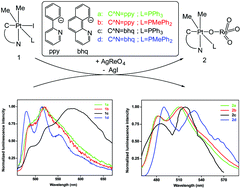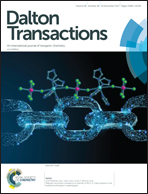Phosphorescent heterobimetallic complexes involving platinum(iv) and rhenium(vii) centers connected by an unsupported μ-oxido bridge†
Abstract
Heterobimetallic compounds [(C^N)LMe2Pt(μ-O)ReO3] (C^N = ppy, L = PPh3, 2a; C^N = ppy, L = PMePh2, 2b; C^N = bhq, L = PPh3, 2c; C^N = bhq, L = PMePh2, 2d) containing a discrete unsupported Pt(IV)–O–Re(VII) bridge have been synthesized through a targeted synthesis route. The compounds have been prepared by a single-pot synthesis in which the Pt(IV) precursor [PtMe2I(C^N)L] complexes are allowed to react easily with AgReO4 in which the iodide ligand of the starting Pt(IV) complex is replaced by an ReO4− anion. In these Pt–O–Re complexes, the Pt(IV) centers have an octahedral geometry, completed by a cyclometalated bidentate ligand (C^N), two methyl groups and a phosphine ligand, while the Re(VII) centers have a tetrahedral geometry. Elemental analysis, single crystal X-ray diffraction analysis and multinuclear NMR spectroscopy are used to establish their identities. The new complexes exhibit phosphorescence emission in the solid and solution states at 298 and 77 K, which is an uncommon property of platinum complexes with an oxidation state of +4. According to DFT calculations, we found that this emission behavior in the new complexes originates from ligand centered 3LC (C^N) character with a slight amount of metal to ligand charge transfer (3MLCT). The solid-state emission data of the corresponding cycloplatinated(IV) precursor complexes [PtMe2I(C^N)L], 1a–1d, pointed out that the replacement of I− by an ReO4− anion helps enhancing the emission efficiency besides shifting the emission wavelengths.



 Please wait while we load your content...
Please wait while we load your content...